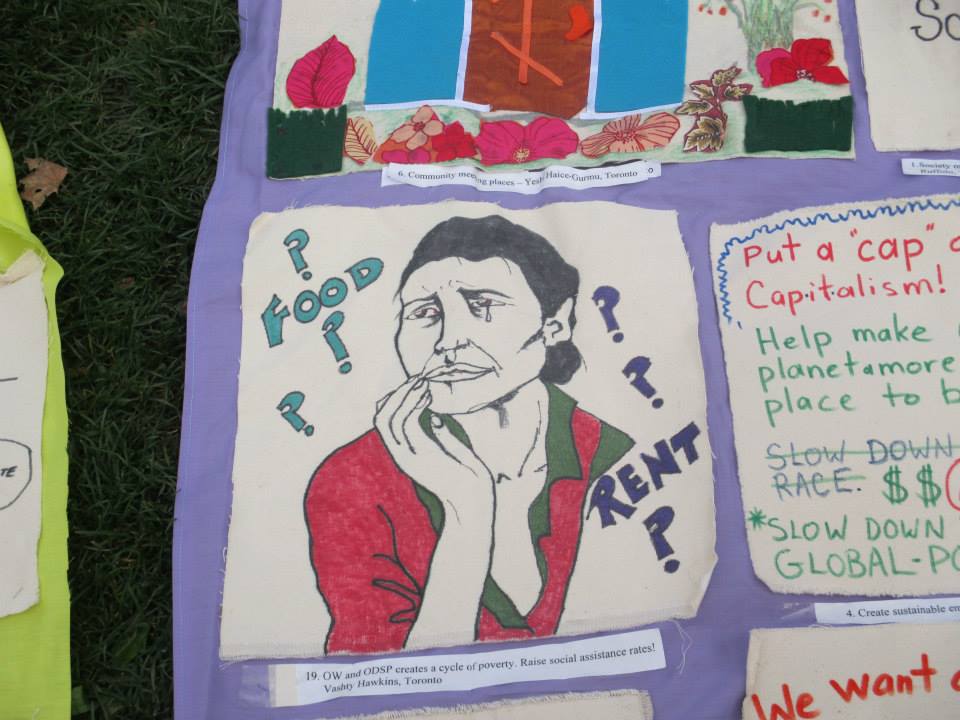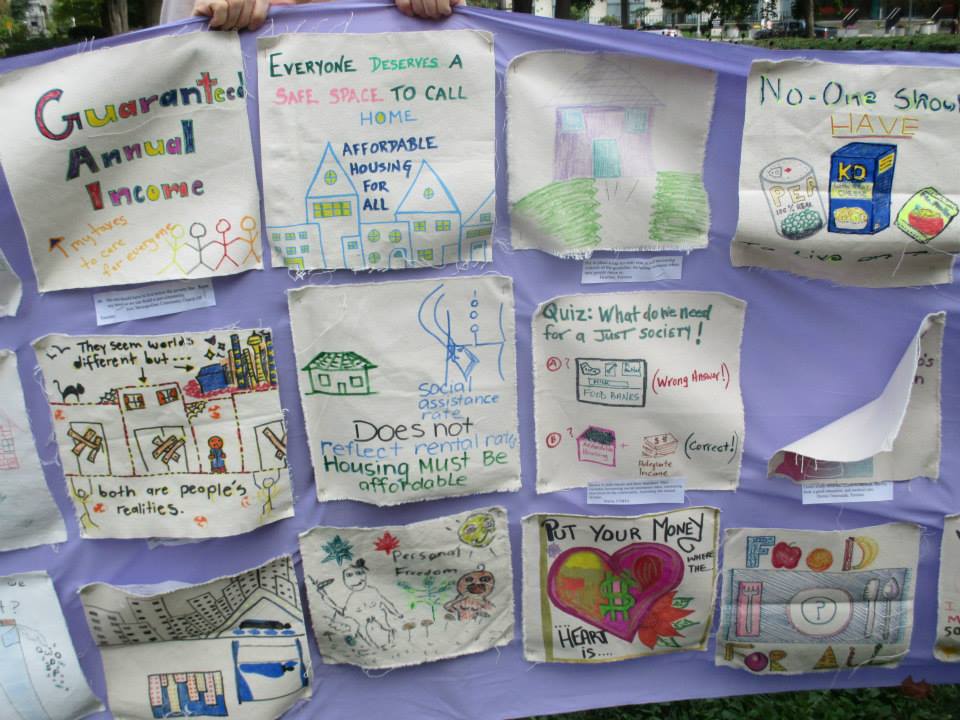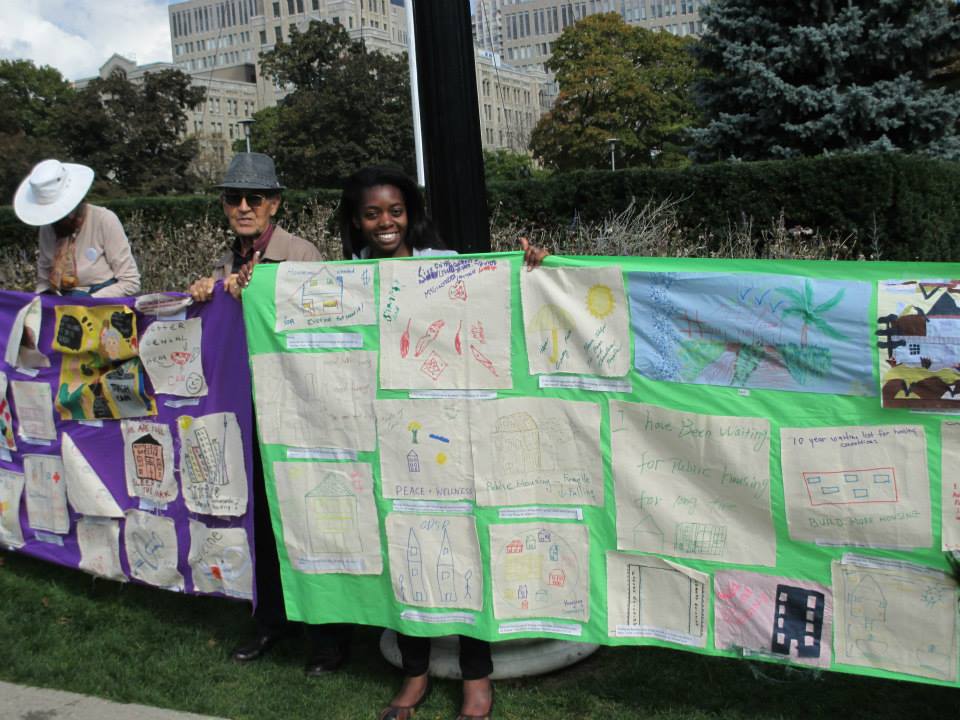People living in poverty unveiled a collective art piece more than 175 feet long on the Ontario Government lawn on October 17 to mark the International Day for the Eradication of Poverty. They urged the Wynne Government to repair the frayed social safety net.
More than 500 individuals and groups from across Ontario joined the Stitching Our Own Social Safety Net campaign. They created artistic squares that, stitched together, represent a whole and complete social safety net. They show the need for new affordable housing, higher social assistance rates, a higher minimum wage, improved dental care and lower post-secondary tuition, employment equity, among other important public supports.
“The Wynne Government must stop focusing on economic austerity and program cuts. They should instead repair our social safety net and fund social programs to lift people out of poverty and help the economy,” said ODSP recipient Veronica Snooks.
Christine Treboute, active in the campaign, stressed the need for supportive housing, which helped her recover from mental illness. “Without supportive housing, a lot of people end up homeless. Right now there are 5,000 people on the waiting list, which means people are often waiting more than five years to get into supportive housing. When disabled people have to wait that long, their health deteriorates, and they end up in an even worse situation. This also ends up costing the system more money in terms of health care and shelter costs.”
The coalition takes aim at the Ontario government and Kathleen Wynne, Premier for less than a year, who calls herself the “social justice premier.” The event also coincides with government consultations on its second round of the Poverty Reduction Strategy, first introduced in 2008 with a focus on children.
The campaign calls on the Wynne government to take immediate action in five key areas, which will focus on the growing number of adults who live in poverty. This work must be done, paying attention to the particular barriers faced by equity seeking groups and must tackle racialized poverty.
“The Ontario government boasts that this province has the lowest program spending per capita in Canada. In the past 20 years, Ontario has seen the highest increase in income inequality in Canada. This trend must be reversed. Everyone needs a strong social safety net,” said Naomi Berlyne, Campaign Coordinator.
Workshops to create the art squares were held across Ontario for eight months, in communities including Kitchener, Wawa, Sudbury, Ottawa, Port Colborne, Fort Erie, Crystal Beach, Thornhill, Mississauga, Alliston, Markham, Thunder Bay, Richmond Hill, Hickson, Cambridge and Toronto. The campaign is widely endorsed by social service agencies, faith communities, unions and justice seeking groups.
A key demand is to hike Ontario Disability Support Program payments by 23 per cent, and Ontario Works payments by 55 per cent. The coalition is largely made up of people on social assistance, who experience first hand the poverty resulting from stagnant benefit rates. “With the rising cost of living, OW and ODSP benefits are now lower than they were in 2003 when the McGuinty government took office,” said Berlyne.
The demand for one per cent of the budget to be spent on sustainable, safe, truly affordable and quality housing was stressed by coalition member and ODSP recipient Daniela Mergarten in her speech to the crowd at Queen’s Park: “It is an abomination that we have women and children in shelters, and 190,000 individuals waiting for public housing in Ontario.” She stressed that the housing situation will worsen when federal funding for new affordable housing drops to zero in 2015.
The group demands our public health care system fully fund dental services for all people on fixed incomes and the working poor. The Ontario Oral Health Alliance Ontario’s says many hospital emergency visits are a result of dental problems, which often lead to other chronic health problems. The Alliance says emergency visits are much more costly than the projected cost of fully funding public dental programs.
Veronica Snooks, has first hand experience with having to choose between dental care, paying the rent and putting food on the table. She is aghast that Ontario did not make good on a promise in its first poverty reduction strategy in 2008, to increase access to oral health care for children in low-income families.
“The strategy promised $45 million a year for dental programs for low-income people. Since then the Ontario government has made many decisions that have both limited access to this program and directed unused funds to other health promotion program, programs that are worthy in their own right but should not be implemented at the expense of the Healthy Smiles program,” said Snooks.

The coalition wants Ontario’s post-secondary tuition fees lowered by 30 per cent for all students. Ontario students face the highest tuition fees of any province in Canada. Meanwhile, the Ontario Government is allowing tuition fees to rise yet again.
The Canadian Federation of Students (CFS) reports that the recently introduced Ontario Tuition Grant “is not truly 30 per cent of tuition fees and was accessed by less than one-quarter of post-secondary students this past year due to its restrictive eligibility requirements.”
CFS found provincial funding currently accounts for less than half of university and college operating funding, down from 70 per cent to 75 per cent just two decades ago. During the Liberal reign in Ontario, post-secondary fees have increased rapidly, as much as 71 per cent for domestic students since 2006.
Statistics Canada reported in 2009 that on average, an undergraduate student in Ontario is saddled with $37,000 in public and private debt.
The campaign joined the Workers Action Centre call to raise the Ontario minimum wage to $14 an hour and index it to the cost of living. WAC reports that in the three years since Ontario’s minimum wage was frozen, inflation has driven minimum wage earnings to 19 per cent below the poverty line.

The Ontario Common Front reports that between 1981 and 2012, Ontario experienced the highest increase in income inequality of anywhere in Canada, and the second highest increase in poverty of all provinces.
A new study from the Wellesley Institute reveals that minimum wage work doubled in Ontario between 2003 and 2011, and those working in minimum wage jobs include a significant number of people over age 25, women, recent immigrants and people from racialized communities. Freezing the minimum wage slows down the economy, since, according to Statistics Canada, household spending contributes to 54 per cent of gross domestic product.
The coalition challenges the Wynne Government decision to make deficit cutting the top priority. They question the priorities of Premier Wynne’s inaugural spring 2013 budget, which continued down the path of austerity, promising to implement six per cent of the Drummond Commission’s recommendations for cuts to important social programs.
And they are alarmed that Ontario Finance’s Minister Charles Sousa stated publicly in April 2013 that “Ontario already has the lowest spending per capita in Canada when it comes to providing public services.”
The Canadian Centre for Policy Alternatives reports that Ontario’s deficit is shrinking faster than predicted, and that further cuts will only weaken the economy, as poverty will increase. Ontario’s deficit for 2012-2013 shrank from a two-year forecast of $15.9 billion to about $9.8 billion in this budget. “Based on this trend, we could reasonably expect the deficit for 2015-16 in this plan to be, at most, $4.8 billion,” states the CCPA.
Between 2008 and 2012, government stimulus kept the recession from worsening in Ontario.
“We don’t need more austerity. We need the Wynne government to increase corporate taxes. Further tax cuts under the Ontario Liberals have reduced government coffers, taking this province further down the path that the Harris government began,” said Berlyne.
Beginning in November, parts of the quilt will be on display at social service agencies who took part in the “art in action” workshops. Organizers are also pushing for a display of the quilt at Toronto City Hall. The coalition hopes to tour with the massive quilt replete with artistic squares, taking their message for a strengthened safety net across the province.
For more information, photos and coverage on the quilt please visit the Stiching Our Own Social Safety Net website.
Helen Armstrong is an anti-poverty activist and member of the Stitching our Own Social Safety Net campaign. She has been a freelance journalist in Toronto for 20 years, writing on social justice issues.



